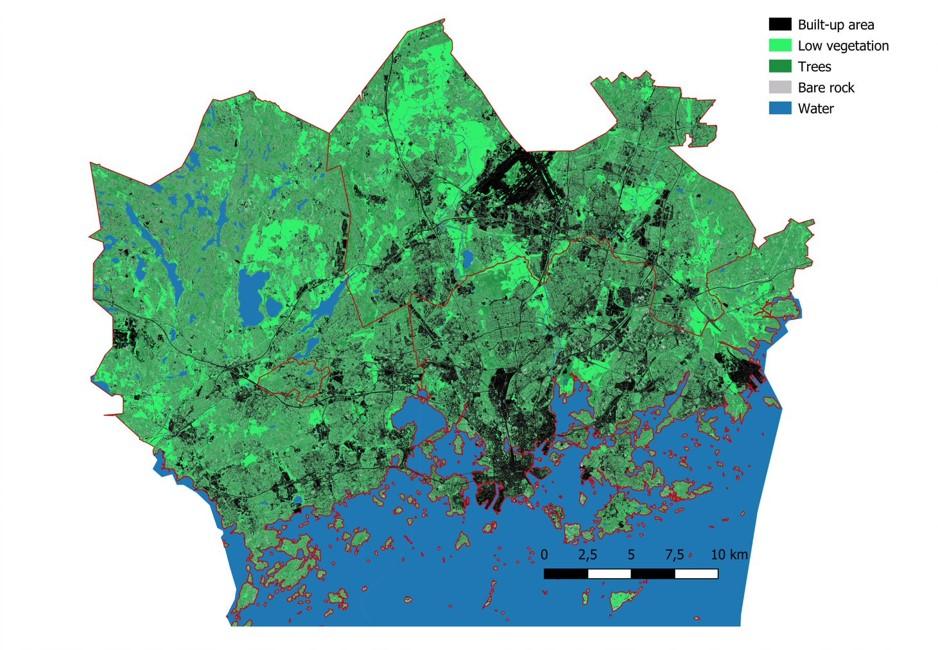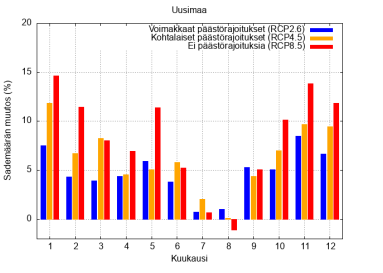Nature-based solutions for stormwater management in the Helsinki Metropolitan Area, Finland – Prerequisites and good practices
Information
Helsinki Region Environmental Services Authority
30.12.2021
Nature-based solutions for stormwater management in the Helsinki Metropolitan Area, Finland – Prerequisites and good practices
Helsinki Region Environmental Services Authority
P.O. BOX 100
00066 HSY
Tel +358 9 1561 2110
Faksi 09 1561 2011
www.hsy.fi
Author: Niina Kautto
Further information:
Maaria Parry, maaria.parry@hsy.fi
Cover photo: HSY/ Mikko Käkelä
Characterising the Helsinki Metropolitan Area
Helsinki Metropolitan Area and stormwater related challenges
The Helsinki Metropolitan Area comprises of four cities: Helsinki, Espoo, Vantaa and Kauniainen. It is an important growth centre with a population of 1.2 million in the autumn 2021 (Statistics Finland 2021), i.e. roughly one-fifth of the Finnish population. The HMA is one of the country’s most significant foci in new construction. The Helsinki Metropolitan Area belongs to the Helsinki-Uusimaa Region. Main stormwater management challenges defined in the RAINMAN project include increasing impermeable surfaces, capacity of the stormwater sewer network, combined sewerage in the centre of Helsinki, varying quality of stormwater as well as storing of stormwater data in many different places (Jarva et al., forthcoming).
Even though Finland is generally speaking a sparsely populated compared to many other countries, even here cities face the pressures of densification. Figure 5 shows the impermeable surface area in the HMA: 28% of the surface area is built-up (including roads, buildings, other impermeable surface as well as bare rock), 69% is vegetation (low vegetation and trees) and 3% inland water.

With regard to the land use types defined at the outset of the project, only Helsinki has historic built-up areas; the rest of the HMA cities include the other three land use types (green or natural areas, developing or rural areas, densely built-up areas).
Central Helsinki includes the historic and densely built-up areas and has a combined sewer system: the wastewater and stormwater are conveyed to the same sewer and onto the Viikinmäki wastewater treatment plant (Fig. 6). In the event of heavy rains, a quick peak of stormwater can form. This increases the risk of overflow of the combined sewage system, which in turn means that impurified water can eventually end up in the Baltic Sea. Moreover, stormwater cools down the wastewater and hence reduces the treatment efficiency at the wastewater treatment plant (HSY n.d.b). There are plans to separate stormwater from the combined sewer in a few parts of central Helsinki, but this is expected to happen slowly (Ala-Prinkkilä 2019).

With regard to the challenge related to managing stormwater data, it has been recognised that these data concerning stormwater, e.g. data on sewers, retention structures, ditches and streams are scattered and have been stored under different organisations. HSY identified the need to develop the management of stormwater data and started a project on a shared stormwater database (HUTI – Hulevesitiedonhallinta, i.e., stormwater data management) in 2019. Such a shared database allows for a more effective city planning, street design and maintenance of the abovementioned structures. After the formulation of a suitable content structure for the database, the project work includes standardising all data to the HUTI format and building a GIS-based application for the users of the stormwater data. The HUTI database is intended for professional use and requires a personal licence.
Stormwater management duties and responsibilities
Stormwater management duties and responsibilities are divided between the metropolitan cities, owners or occupiers of properties, and the joint municipal authority Helsinki Region Environmental Services, HSY. The following points are based on the legislation and the stormwater management agreements between the HSY and the HMA cities (HSY, n.d.c):
- Cities are responsible for planning of the stormwater management as a whole within their territory. This includes preparing a stormwater management plan, assessing stormwater flood risks, and taking care of stormwater management in public areas, such as water removal from streets and flood routes. In addition, cities are responsible for the construction and maintenance of the municipality’s stormwater systems, such as open ditches as well as detention and retention structures.
- HSY is responsible for the construction and maintenance of the main stormwater sewer network in a separately defined stormwater sewerage area and owns the stormwater pipe network. HSY provides stormwater sewerage services in this stormwater sewerage area approved by its member municipalities. HSY charges connection fees and basic rates for stormwater sewerage.
- The owner or occupier of the property is responsible for the drainage of the building and the management of stormwater formed on the property. They should have a plan for conveying and treating stormwater. Stormwater can be infiltrated and detained as well as conveyed into HSY’s stormwater sewer or the municipality’s stormwater system in a controlled manner. The property must be connected to HSY’s stormwater sewer if it is located in the stormwater sewerage area. Even if the property owner infiltrates stormwaters in their property, that does not remove the obligation to join the HSY’s stormwater sewer system.
As a rule, stormwater conducted into the stormwater sewer network is not treated, but rather discharged into water bodies as such. Stormwaters must not be conducted into the wastewater sewer network except in the combined sewerage area.
Steering mechanisms related to stormwater management
Essential steering measures and legislation on stormwater management are (the most important ones are bolded) (Airamo 2018):
- Land Use and Building Act and its amendment (Maankäyttö- ja rakennuslaki 132/1999, Laki maankäyttö- ja rakennuslain muuttamisesta 682/2014)
- Water Services Act (Vesihuoltolaki 119/2001)
- Water Act (Vesilaki 587/2011)
- Flood Risk Management Act (Laki tulvariskien hallinnasta 620/2010)
- Act on the Organisation of River Basin Management and the Marine Strategy (Laki vesienhoidon ja merenhoidon järjestämisestä 1299/2004)
- Environmental Protection Act (Ympäristönsuojelulaki 527/2014)
- Street and specific public areas’ maintenance act (Laki kadun ja eräiden yleisten alueiden kunnossa- ja puhtaanapidosta 699/1978; no English translation)
- Decree of the Ministry of Environment on water and sewer equipment of buildings (Ympäristöministeriön asetus rakennusten vesi- ja viemärilaitteistoista 1047/2017; no English translation).
Importantly, the Land Use and Building Act was amended in 2014 (with a new chapter 13a) to reduce stormwater damages and to require municipalities to organise stormwater management in their local detailed plan areas. Essentially, the general objectives of storm water management specified in the law are as follows (City of Helsinki 2018; Ympäristöministeriö 2014):
- developing systematic stormwater management especially in areas where a local detailed plan is in force;
- infiltrating and detaining stormwater at the source;
- preventing the impacts and damages to the environment and property caused by stormwater, while taking account of climate change;
- promote giving up the practice to convey storm water into wastewater sewers.
Regulation of stormwater management was considered appropriate to include in the Land Use and Building Act because stormwaters need to be taken into account both in land use planning and building. Good stormwater management is part of a healthy and safe living environment, which is also the objective of town planning. (Ulvi 2016).
In addition, a comprehensive guide of the Association of Finnish Local and Regional Authorities (Kuntaliitto, 2012) on stormwater management emphasises integrated stormwater management and source control. The Finnish Association of Landscape Industries (Weckman 2018) has also published a guiding document on an operational model for sustainable environmental building that includes stormwater management. This organisation is also currently preparing a maintenance classification as well as quality criteria of natural stormwater structures (VYL 2021).
Furthermore, municipalities have to assess stormwater flood risks according to the law (Act 620/2010). This means carrying out an initial assessment of stormwater flood risks and naming of possible significant stormwater flood risk areas. If this assessment shows such significant stormwater flood risk areas, then the municipality needs to develop more detailed assessments, flood risk maps and stormwater management plans. The nation-wide stormwater flood risk assessment round ended in 2018, the next will take place in 6 years. This is because land use is continuously changing, and heavy rains are increasing. (Ala-Prinkkilä 2019). In the 2018 assessment, no significant stormwater flood risk areas were found in the HMA cities.
In the Helsinki Metropolitan Area, three out of four cities have a stormwater management program (Helsinki, Espoo and Vantaa). Stormwater management issues are also recognised in the cities’ climate change adaptation plans. In addition, they have been included in the HMA wide climate change adaptation strategy for the years 2012-2020 (HSY 2012), and reported in the strategy’s monitoring reports. Sections 6-9 present the cities’ stormwater management documents more in detail.
Climate change impacts
Currently, summer is the rainiest season, and cloudbursts take place in the warmest time of the year in Finland. Valtanen et al. (2014, cited in Kuoppamäki 2021) has estimated that 65-69% of stormwater is formed in the summer. Thus far, smaller rain events have been most common in the country. (Kuoppamäki 2021).
The Finnish Climate Change Panel published a report on changes in weather and climate factors in each Finnish region in September 2021 (Gregow et al. 2021). According to the report, depending on how global greenhouse gas emissions will evolve in the coming decades, the mean temperature is expected to be 1,7 to 2,8 °C warmer than today in the Helsinki-Uusimaa Region by the end of the century. This is anticipated to lead to an increase in precipitation as shown in Figure 7. Figure 7 shows that even with strong emission reductions (in line with the IPCC RCP2.6 scenario), precipitation is anticipated to increase in winter, spring and autumn. The intensity of cloudbursts is on the rise in all seasons. (Gregow et al. 2021).

According to a report investigating climate change impacts in the Helsinki Metropolitan Area, both the mean and maximum precipitation will increase, especially in winter months, and heavy rainfall events in the summer will intensify by 10% during this century (Mäkelä et al. 2016).
Climate change is also expected to increase the volume of cloudbursts. Cloudbursts are usually a local phenomenon and the probability of heavy rainfall to land in densely built urban areas is relatively low (Mäkelä et al. 2016). However, cloudburst events like the ones in Pori (August 2007), and Helsinki (August 2019) indicate that heavy rains can cause considerable damage (Hevonoja et al. 2019, SYKE 2021).
The risk of stormwater floods will increase in the future along with increased cloudburst events, and this risk is recommended to be prepared for. Estimated climate change impacts also include sea level rise and increased risk of sea floods. (Gregow et al. 2021). This is expected to affect stormwater management systems especially if cloudburst events and elevated sea levels happen simultaneously.

